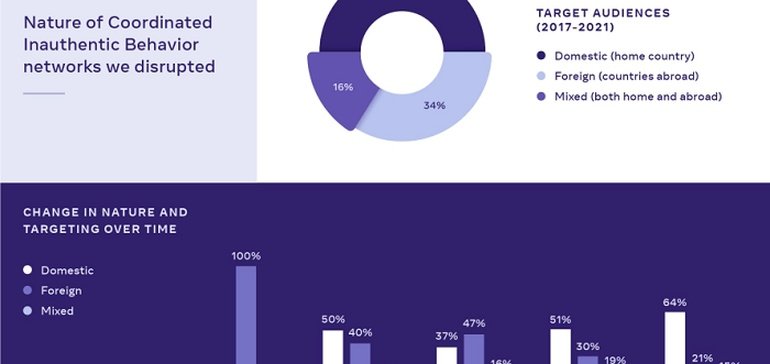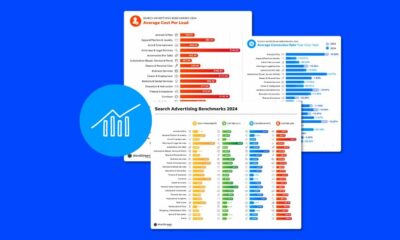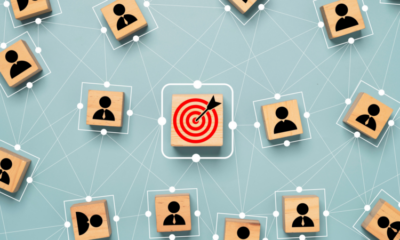SOCIAL
Meta Releases New Insights into its Evolving Efforts to Detect Coordinated Manipulation Programs

Meta has shared some new insights into its ongoing efforts to combat coordinated misinformation networks operating across its platforms, which became a major focus for the company following the 2016 US Election, and the revelations that Russian-backed teams had sought to sway the opinions of American voters.
As explained by Meta:
“Since 2017, we’ve reported on over 150 influence operations with details on each network takedown so that people know about the threats we see – whether they come from nation states, commercial firms or unattributed groups. Information sharing enabled our teams, investigative journalists, government officials and industry peers to better understand and expose internet-wide security risks, including ahead of critical elections.”
Meta publishes a monthly round-up of the networks that it’s detected and removed, via automated, user-reported, and other collaborative means, which has broadened its net in working to catch out these groups.
And some interesting trends have emerged in Meta’s enforcement data over time – first off, Meta has provided this overview of where the groups that it has detected and taken action on have originated from.
As you can see, while there have been various groups detected within Russia’s borders, there’s also been a cluster of activity originating from Iran and the surrounding regions, while more recently, Meta has taken action against several groups operating in Mexico.
But even more interesting is Meta’s data on the regions that these groups have been targeting, with a clear shift away from foreign interference, and towards domestic misinformation initiatives.

As shown in these charts, there’s been a significant move away from international pushes, with localized operations becoming more prevalent, at least in terms of what Meta’s teams have been able to detect.
Which is the other side of the research – those looking to utilize Meta’s platforms for such purpose are always evolving their tactics, in order to avoid detection, and it could be that more groups are still operating outside of Meta’s scope, so this may not be a complete view of misinformation campaign trends, as such.
But Meta has been upping its game, and it does appear to be paying off, with more coordinated misinformation pushes being caught out, and more action being taken to hold perpetrators accountable, in an effort to disincentivize similar programs in future.
But really, it’s going to keep happening. Facebook has reach to almost 3 billion people, while Instagram has over a billion users (reportedly now over 2 billion, though Meta has not confirmed this), and that’s before you consider WhatsApp, which has more than 2 billion users in its own right. At such scale, each of these platforms offers a massive opportunity for amplification of politically-motivated messaging, and while bad actors are able to tap into the amplification potential that each app provides, they will continue to seek ways to do so.
Which is a side effect of operating such popular networks, and one that Meta, for a long time, had either overlooked or refused to see. Most social networks were founded on the principle of connecting the world, and bringing people together, and that core ethos is what motivates all of their innovations and processes, with a view to a better society through increased community understanding, in global terms.
That’s an admirable goal, but the flip side of that is that social platforms also enable those with bad motivations to also connect and establish their own networks, and expand their potentially dangerous messaging throughout the same networks.
The clash of idealism and reality has often seemed to flummox social platform CEOs, who, again, would prefer to see the potential good over all else. Crypto networks are now in a similar boat, with massive potential to connect the world, and bring people together, but equally, the opportunity to facilitate money laundering, large-scale scams, tax evasion and potentially worse.
Getting the balance right is difficult, but as we now know, through experience, the impacts of failing to see these gaps can be significant.
Which is why these efforts are so important, and it’s interesting to note both the increasing push from Meta’s teams, and the evolution in tactics from bad actors.
My view? Localized groups, after learning how Russian groups sought to influence the US election, have sought to utilize the same tactics on a local level, meaning that past enforcement has also inadvertently highlighted how Meta’s platforms can be used for such purpose.
That’s likely to continue to be the case moving forward, and hopefully, Meta’s evolving actions will ensure better detection and removal of these initiatives before they can take effect.
You can read Meta’s Coordinated Misinformation Report for December 2021 here.
Source link
SOCIAL
Snapchat Explores New Messaging Retention Feature: A Game-Changer or Risky Move?

In a recent announcement, Snapchat revealed a groundbreaking update that challenges its traditional design ethos. The platform is experimenting with an option that allows users to defy the 24-hour auto-delete rule, a feature synonymous with Snapchat’s ephemeral messaging model.
The proposed change aims to introduce a “Never delete” option in messaging retention settings, aligning Snapchat more closely with conventional messaging apps. While this move may blur Snapchat’s distinctive selling point, Snap appears convinced of its necessity.
According to Snap, the decision stems from user feedback and a commitment to innovation based on user needs. The company aims to provide greater flexibility and control over conversations, catering to the preferences of its community.
Currently undergoing trials in select markets, the new feature empowers users to adjust retention settings on a conversation-by-conversation basis. Flexibility remains paramount, with participants able to modify settings within chats and receive in-chat notifications to ensure transparency.
Snapchat underscores that the default auto-delete feature will persist, reinforcing its design philosophy centered on ephemerality. However, with the app gaining traction as a primary messaging platform, the option offers users a means to preserve longer chat histories.
The update marks a pivotal moment for Snapchat, renowned for its disappearing message premise, especially popular among younger demographics. Retaining this focus has been pivotal to Snapchat’s identity, but the shift suggests a broader strategy aimed at diversifying its user base.
This strategy may appeal particularly to older demographics, potentially extending Snapchat’s relevance as users age. By emulating features of conventional messaging platforms, Snapchat seeks to enhance its appeal and broaden its reach.
Yet, the introduction of message retention poses questions about Snapchat’s uniqueness. While addressing user demands, the risk of diluting Snapchat’s distinctiveness looms large.
As Snapchat ventures into uncharted territory, the outcome of this experiment remains uncertain. Will message retention propel Snapchat to new heights, or will it compromise the platform’s uniqueness?
Only time will tell.
SOCIAL
Catering to specific audience boosts your business, says accountant turned coach

While it is tempting to try to appeal to a broad audience, the founder of alcohol-free coaching service Just the Tonic, Sandra Parker, believes the best thing you can do for your business is focus on your niche. Here’s how she did just that.
When running a business, reaching out to as many clients as possible can be tempting. But it also risks making your marketing “too generic,” warns Sandra Parker, the founder of Just The Tonic Coaching.
“From the very start of my business, I knew exactly who I could help and who I couldn’t,” Parker told My Biggest Lessons.
Parker struggled with alcohol dependence as a young professional. Today, her business targets high-achieving individuals who face challenges similar to those she had early in her career.
“I understand their frustrations, I understand their fears, and I understand their coping mechanisms and the stories they’re telling themselves,” Parker said. “Because of that, I’m able to market very effectively, to speak in a language that they understand, and am able to reach them.”Â
“I believe that it’s really important that you know exactly who your customer or your client is, and you target them, and you resist the temptation to make your marketing too generic to try and reach everyone,” she explained.
“If you speak specifically to your target clients, you will reach them, and I believe that’s the way that you’re going to be more successful.
Watch the video for more of Sandra Parker’s biggest lessons.
SOCIAL
Instagram Tests Live-Stream Games to Enhance Engagement

Instagram’s testing out some new options to help spice up your live-streams in the app, with some live broadcasters now able to select a game that they can play with viewers in-stream.
As you can see in these example screens, posted by Ahmed Ghanem, some creators now have the option to play either “This or That”, a question and answer prompt that you can share with your viewers, or “Trivia”, to generate more engagement within your IG live-streams.
That could be a simple way to spark more conversation and interaction, which could then lead into further engagement opportunities from your live audience.
Meta’s been exploring more ways to make live-streaming a bigger consideration for IG creators, with a view to live-streams potentially catching on with more users.
That includes the gradual expansion of its “Stars” live-stream donation program, giving more creators in more regions a means to accept donations from live-stream viewers, while back in December, Instagram also added some new options to make it easier to go live using third-party tools via desktop PCs.
Live streaming has been a major shift in China, where shopping live-streams, in particular, have led to massive opportunities for streaming platforms. They haven’t caught on in the same way in Western regions, but as TikTok and YouTube look to push live-stream adoption, there is still a chance that they will become a much bigger element in future.
Which is why IG is also trying to stay in touch, and add more ways for its creators to engage via streams. Live-stream games is another element within this, which could make this a better community-building, and potentially sales-driving option.
We’ve asked Instagram for more information on this test, and we’ll update this post if/when we hear back.
-

 MARKETING7 days ago
MARKETING7 days agoA Recap of Everything Marketers & Advertisers Need to Know
-

 PPC5 days ago
PPC5 days agoHow the TikTok Algorithm Works in 2024 (+9 Ways to Go Viral)
-

 SEO6 days ago
SEO6 days agoBlog Post Checklist: Check All Prior to Hitting “Publish”
-

 SEO4 days ago
SEO4 days agoHow to Use Keywords for SEO: The Complete Beginner’s Guide
-

 MARKETING5 days ago
MARKETING5 days agoHow To Protect Your People and Brand
-

 SEARCHENGINES6 days ago
SEARCHENGINES6 days agoGoogle Started Enforcing The Site Reputation Abuse Policy
-

 PPC6 days ago
PPC6 days agoHow to Craft Compelling Google Ads for eCommerce
-

 MARKETING6 days ago
MARKETING6 days agoElevating Women in SEO for a More Inclusive Industry
















You must be logged in to post a comment Login